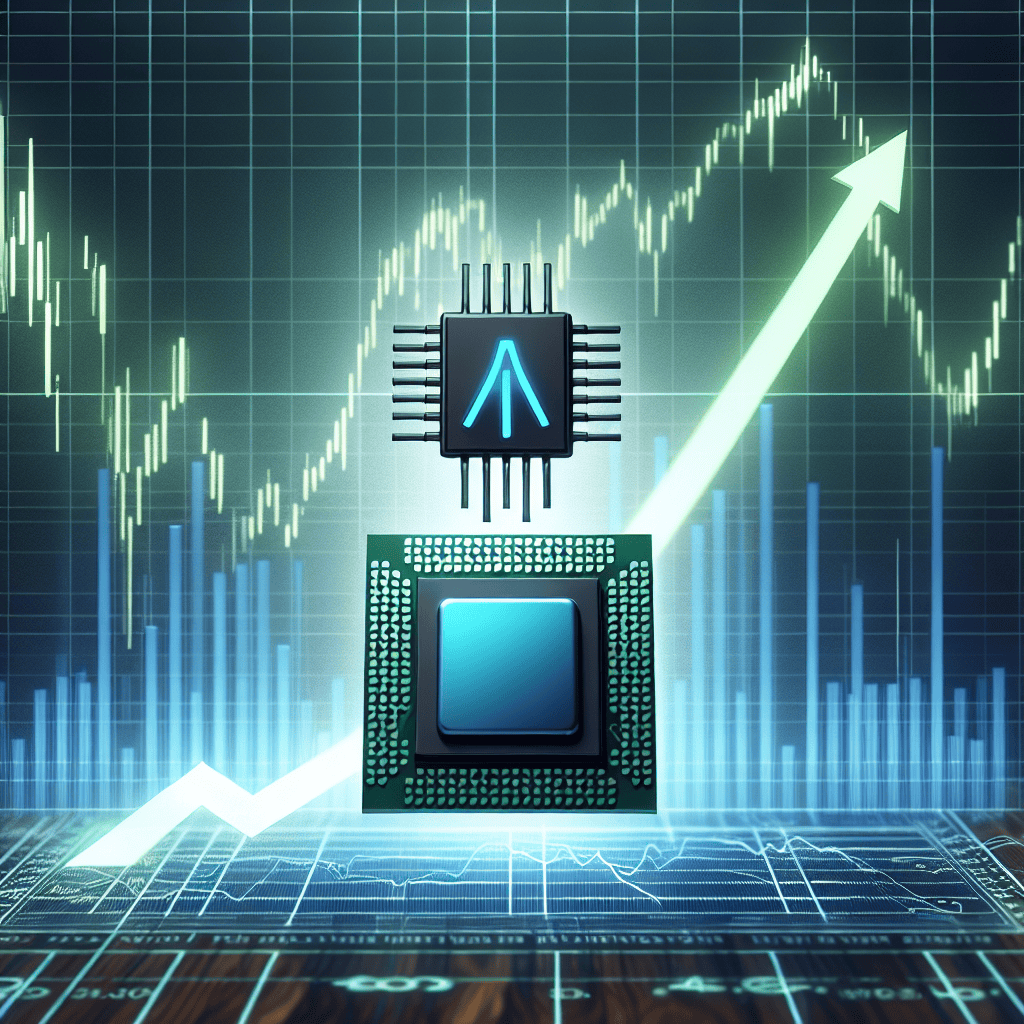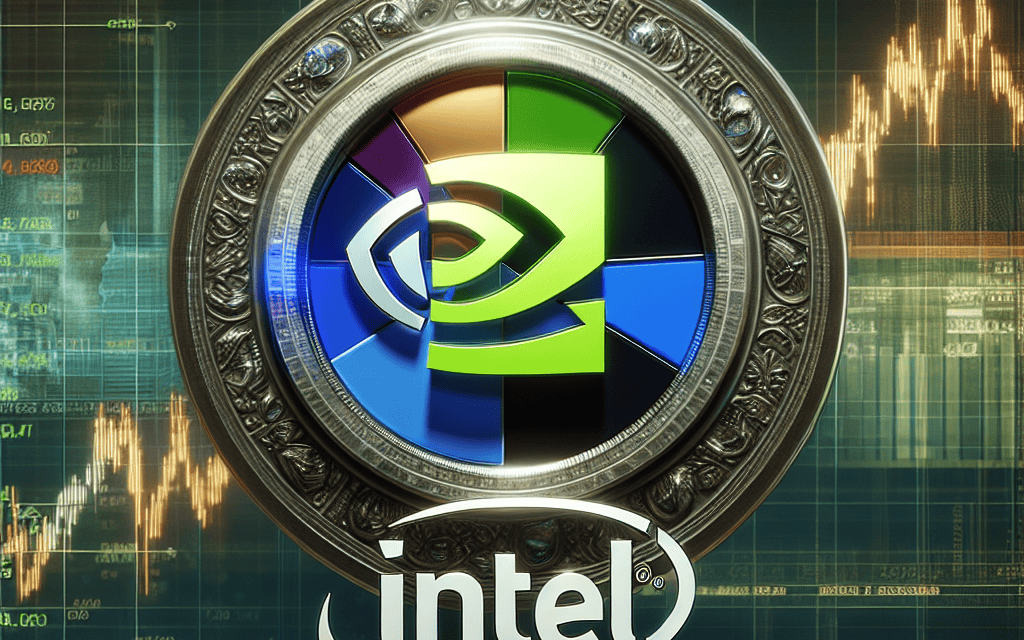“Powering the Future: Nvidia Takes the Lead on the Dow Jones Industrial Average”
Introduction
In a significant reshuffle of the Dow Jones Industrial Average, Nvidia has replaced Intel, marking a pivotal moment in the semiconductor industry and the broader technology sector. This change reflects Nvidia’s growing influence and dominance in areas such as artificial intelligence, gaming, and data centers, where its advanced graphics processing units (GPUs) have become essential. Meanwhile, Intel, once a stalwart of the tech industry, has faced challenges in adapting to rapidly evolving market demands and competition. Nvidia’s inclusion in the Dow underscores the shifting landscape of technology and highlights the increasing importance of companies that are driving innovation in high-performance computing and AI. This move not only signifies a change in the composition of the Dow but also represents a broader trend towards embracing companies that are at the forefront of technological advancement.
Impact Of Nvidia’s Inclusion In The Dow Jones Industrial Average
The inclusion of Nvidia in the Dow Jones Industrial Average marks a significant shift in the landscape of the stock market, reflecting broader changes in the global economy and the technology sector. This transition, which sees Nvidia replacing Intel, underscores the growing importance of artificial intelligence and graphics processing in today’s digital age. As Nvidia steps into this prestigious index, it not only highlights the company’s remarkable growth and influence but also signals a shift in investor focus towards companies that are at the forefront of technological innovation.
Nvidia’s inclusion in the Dow Jones Industrial Average is a testament to its pivotal role in the tech industry. Over the past few years, Nvidia has emerged as a leader in graphics processing units (GPUs), which are essential for a wide range of applications, from gaming to data centers and artificial intelligence. The company’s advancements in AI technology have positioned it as a key player in the development of autonomous vehicles, machine learning, and other cutting-edge technologies. This has not only driven Nvidia’s stock price to new heights but has also made it an attractive option for investors seeking exposure to the rapidly evolving tech sector.
The replacement of Intel by Nvidia in the Dow Jones Industrial Average also reflects a broader trend in the stock market, where traditional hardware companies are being overshadowed by firms that are more focused on software and digital solutions. Intel, once a dominant force in the semiconductor industry, has faced increasing competition and challenges in recent years. The rise of mobile computing, cloud services, and AI has shifted the focus away from traditional PC processors, which were Intel’s stronghold, towards more versatile and powerful GPUs. This shift has allowed companies like Nvidia to capture a larger share of the market and become more relevant to investors.
Moreover, Nvidia’s inclusion in the Dow Jones Industrial Average is likely to have a significant impact on the index itself. As one of the most widely followed stock market indices, the Dow Jones serves as a barometer for the overall health of the U.S. economy. By incorporating Nvidia, the index is better positioned to reflect the current state of the tech industry and the broader economy. This change may also influence investment strategies, as fund managers and individual investors adjust their portfolios to align with the new composition of the index.
In addition to its impact on the stock market, Nvidia’s inclusion in the Dow Jones Industrial Average highlights the increasing importance of technology in everyday life. As digital transformation continues to accelerate across various industries, companies that are able to harness the power of technology to drive innovation and growth are likely to play a crucial role in shaping the future. Nvidia’s success in leveraging its expertise in GPUs and AI to expand into new markets serves as a prime example of how technology companies can adapt and thrive in a rapidly changing environment.
In conclusion, Nvidia’s replacement of Intel in the Dow Jones Industrial Average is a reflection of the shifting dynamics within the tech industry and the stock market. It underscores the growing significance of AI and digital solutions, while also highlighting the challenges faced by traditional hardware companies. As Nvidia takes its place among the elite companies in the Dow Jones, it not only cements its status as a leader in the tech sector but also sets the stage for future growth and innovation.
Historical Context: Nvidia’s Rise And Intel’s Replacement
The Dow Jones Industrial Average (DJIA), a prominent stock market index, has long been a barometer of the American economy, reflecting the performance of 30 significant publicly traded companies. Historically, the composition of the DJIA has evolved to mirror the changing landscape of the U.S. economy, with companies being added or removed based on their relevance and impact. In a significant shift, Nvidia, a leader in graphics processing technology, has replaced Intel, a stalwart in the semiconductor industry, on the DJIA. This change underscores the dynamic nature of the technology sector and highlights Nvidia’s meteoric rise in recent years.
To understand the implications of this transition, it is essential to consider the historical context of both companies. Intel, founded in 1968, has been a pioneer in the semiconductor industry, playing a crucial role in the development of microprocessors that power personal computers and servers. For decades, Intel’s dominance in the market was undisputed, and its inclusion in the DJIA in 1999 was a testament to its influence and importance. However, as the technology landscape evolved, Intel faced increasing competition and challenges, particularly in adapting to the growing demand for mobile and energy-efficient processors.
In contrast, Nvidia, established in 1993, initially focused on developing graphics processing units (GPUs) for gaming. Over time, Nvidia’s innovative approach and strategic investments in research and development allowed it to expand its reach beyond gaming into areas such as artificial intelligence (AI), data centers, and autonomous vehicles. The company’s GPUs have become integral to AI and machine learning applications, providing the computational power necessary for complex data processing tasks. This diversification and forward-thinking strategy have propelled Nvidia to the forefront of the technology sector, making it a key player in shaping the future of computing.
The decision to replace Intel with Nvidia on the DJIA reflects broader trends within the technology industry. As AI and data-driven technologies become increasingly central to various sectors, companies like Nvidia that are at the cutting edge of these innovations gain prominence. This shift also highlights the growing importance of adaptability and innovation in maintaining a competitive edge in the fast-paced tech landscape. While Intel remains a significant player in the semiconductor industry, its challenges in keeping pace with emerging technologies have impacted its standing.
Moreover, Nvidia’s inclusion in the DJIA signifies a recognition of its substantial market capitalization and influence. The company’s impressive financial performance, driven by strong demand for its products across multiple sectors, has solidified its position as a leader in the tech industry. This transition also serves as a reminder of the ever-evolving nature of the stock market, where companies must continuously innovate and adapt to remain relevant.
In conclusion, the replacement of Intel by Nvidia on the Dow Jones Industrial Average marks a pivotal moment in the history of both companies and the broader technology sector. It underscores the importance of innovation and adaptability in an industry characterized by rapid change and highlights Nvidia’s rise as a dominant force in shaping the future of computing. As the technology landscape continues to evolve, the composition of the DJIA will likely reflect these shifts, providing insights into the companies driving economic growth and technological advancement.
Market Reactions To Nvidia’s Dow Jones Debut
Nvidia’s recent inclusion in the Dow Jones Industrial Average, replacing Intel, marks a significant shift in the landscape of the technology sector. This change reflects the evolving dynamics of the industry, as Nvidia’s prominence in areas such as artificial intelligence, gaming, and data centers has grown substantially. The market’s reaction to Nvidia’s debut on the Dow has been noteworthy, with investors and analysts closely monitoring the implications of this transition.
Initially, Nvidia’s addition to the Dow was met with enthusiasm from investors, as the company’s stock experienced a noticeable uptick. This positive response can be attributed to Nvidia’s strong financial performance and its strategic positioning in high-growth markets. Over the past few years, Nvidia has consistently delivered impressive revenue growth, driven by its innovative products and expanding market share. As a result, its inclusion in the Dow is seen as a validation of its success and potential for future growth.
Moreover, Nvidia’s entry into the Dow has prompted a reevaluation of investment strategies among market participants. Many investors view Nvidia as a key player in the future of technology, particularly in the fields of artificial intelligence and machine learning. Consequently, its presence in the Dow is likely to attract more attention from institutional investors who track the index, potentially leading to increased demand for Nvidia’s shares. This shift in investor sentiment underscores the growing importance of companies that are at the forefront of technological innovation.
In contrast, Intel’s removal from the Dow has sparked discussions about the challenges facing traditional semiconductor companies. While Intel remains a significant player in the industry, it has faced increased competition from companies like Nvidia, which have capitalized on emerging trends and technologies. Intel’s exclusion from the Dow serves as a reminder of the need for established companies to adapt and innovate in order to maintain their relevance in a rapidly changing market.
Furthermore, the broader market implications of Nvidia’s inclusion in the Dow cannot be overlooked. As one of the most widely followed stock indices, the Dow Jones Industrial Average serves as a barometer for the overall health of the U.S. economy. Nvidia’s presence in the index highlights the growing influence of technology companies in shaping economic trends. This shift reflects a broader transformation in the economy, where technology-driven innovation is increasingly becoming a key driver of growth.
In addition to its impact on the technology sector, Nvidia’s debut on the Dow has also influenced investor perceptions of the index itself. Traditionally, the Dow has been criticized for its limited representation of the technology sector, given its price-weighted methodology. However, the inclusion of Nvidia, a company with a substantial market capitalization, addresses some of these concerns by providing a more accurate reflection of the current economic landscape.
In conclusion, Nvidia’s replacement of Intel on the Dow Jones Industrial Average has elicited a range of reactions from the market. While it underscores Nvidia’s growing prominence and the shifting dynamics of the technology sector, it also highlights the challenges faced by traditional semiconductor companies. As investors continue to assess the implications of this change, it is clear that Nvidia’s presence in the Dow will have a lasting impact on both the index and the broader market. This development serves as a testament to the transformative power of technology and its role in shaping the future of the global economy.
Nvidia’s Growth Strategy And Its Influence On The Dow

Nvidia’s recent inclusion in the Dow Jones Industrial Average, replacing Intel, marks a significant milestone in the company’s growth trajectory and underscores its influence in the technology sector. This transition reflects not only Nvidia’s robust financial performance but also its strategic positioning in emerging markets that are reshaping the global economy. As we delve into Nvidia’s growth strategy, it becomes evident that the company’s focus on innovation and diversification has been pivotal in its ascent to becoming a key player on the Dow.
To begin with, Nvidia’s strategic emphasis on artificial intelligence (AI) and machine learning has been a cornerstone of its growth. The company has invested heavily in developing cutting-edge AI technologies, which have found applications across various industries, from healthcare to automotive. By positioning itself at the forefront of AI innovation, Nvidia has tapped into a burgeoning market with immense potential for expansion. This focus on AI has not only driven revenue growth but also enhanced Nvidia’s reputation as a leader in technological advancement.
Moreover, Nvidia’s foray into the gaming industry has been another critical component of its growth strategy. The company’s graphics processing units (GPUs) are renowned for their superior performance, making them a preferred choice among gamers worldwide. The gaming sector has experienced exponential growth, particularly during the pandemic, as more individuals turned to digital entertainment. Nvidia’s ability to capitalize on this trend by continuously improving its GPU offerings has solidified its position as a dominant force in the gaming market.
In addition to AI and gaming, Nvidia’s strategic acquisitions have played a vital role in its expansion. The acquisition of Mellanox Technologies, for instance, has bolstered Nvidia’s capabilities in data center solutions, a sector experiencing rapid growth due to the increasing demand for cloud computing and data storage. By integrating Mellanox’s high-performance networking technology, Nvidia has strengthened its data center offerings, thereby broadening its market reach and enhancing its competitive edge.
Furthermore, Nvidia’s commitment to sustainability and energy efficiency has resonated well with investors and consumers alike. The company has made significant strides in developing energy-efficient technologies, which are increasingly important in a world grappling with climate change. By aligning its business practices with global sustainability goals, Nvidia has not only reduced its environmental footprint but also attracted environmentally conscious investors, thereby boosting its market appeal.
Transitioning to the implications of Nvidia’s inclusion in the Dow Jones Industrial Average, it is essential to recognize the symbolic and practical significance of this development. The Dow is a barometer of the U.S. economy, and Nvidia’s presence in this prestigious index highlights the growing importance of technology companies in driving economic growth. This shift also reflects a broader trend of traditional industries being supplanted by tech-driven enterprises, as innovation becomes a key driver of economic progress.
In conclusion, Nvidia’s replacement of Intel on the Dow Jones Industrial Average is a testament to its successful growth strategy and its influence in the technology sector. Through strategic investments in AI, gaming, and data centers, coupled with a commitment to sustainability, Nvidia has positioned itself as a leader in innovation. As the company continues to expand its horizons, its impact on the Dow and the broader economy is likely to grow, underscoring the transformative power of technology in shaping the future.
Comparing Nvidia And Intel: A Shift In Tech Leadership
In a significant reshuffling of the Dow Jones Industrial Average, Nvidia has replaced Intel, marking a pivotal moment in the technology sector. This change reflects broader shifts in the industry, as Nvidia’s innovative advancements in graphics processing units (GPUs) and artificial intelligence (AI) have positioned it as a leader in the tech world. Meanwhile, Intel, once a dominant force in the semiconductor industry, has faced challenges adapting to the rapidly evolving landscape. This transition underscores the dynamic nature of technology leadership and highlights the contrasting paths of these two giants.
Nvidia’s rise to prominence can be attributed to its strategic focus on GPUs, which have become essential in various applications beyond traditional graphics rendering. The company’s GPUs are now integral to AI, machine learning, and data center operations, areas experiencing exponential growth. Nvidia’s ability to capitalize on these trends has not only boosted its financial performance but also solidified its reputation as an innovator. The company’s forward-thinking approach, including its investments in AI research and development, has allowed it to capture significant market share and influence.
In contrast, Intel has encountered several hurdles in recent years. The company, historically known for its dominance in central processing units (CPUs), has struggled to maintain its competitive edge. Delays in transitioning to smaller manufacturing processes and increased competition from companies like AMD have eroded Intel’s market position. Furthermore, the shift towards mobile and cloud computing has diminished the demand for traditional PC processors, areas where Intel once thrived. These challenges have prompted Intel to reevaluate its strategies and seek new growth avenues, such as expanding its presence in the data center and AI markets.
The decision to replace Intel with Nvidia on the Dow Jones Industrial Average is not merely symbolic; it reflects the changing priorities of the technology sector. Investors and analysts are increasingly focused on companies that demonstrate adaptability and innovation in emerging fields. Nvidia’s inclusion in the index signifies a recognition of its role in shaping the future of technology, particularly in AI and data processing. This shift also highlights the growing importance of companies that can leverage cutting-edge technologies to drive growth and create value.
Moreover, this transition serves as a reminder of the cyclical nature of technology leadership. While Intel’s contributions to the industry are undeniable, the company’s recent struggles illustrate the challenges of maintaining dominance in a fast-paced environment. As Nvidia takes its place on the Dow Jones Industrial Average, it faces the task of sustaining its momentum and continuing to innovate. The tech landscape is ever-evolving, and companies must remain agile to navigate the complexities of the market.
In conclusion, the replacement of Intel by Nvidia on the Dow Jones Industrial Average marks a significant shift in tech leadership. Nvidia’s success in capitalizing on emerging technologies and its strategic focus on AI and data processing have propelled it to the forefront of the industry. Meanwhile, Intel’s challenges highlight the difficulties of adapting to changing market dynamics. This transition underscores the importance of innovation and adaptability in the technology sector, as companies strive to lead in an increasingly competitive and transformative environment. As Nvidia assumes its new role, the industry will be watching closely to see how it continues to shape the future of technology.
Implications For Investors: Nvidia’s New Role In The Dow
The recent replacement of Intel by Nvidia on the Dow Jones Industrial Average marks a significant shift in the landscape of the technology sector, with profound implications for investors. This change reflects the evolving dynamics of the tech industry, where Nvidia’s innovative prowess and strategic positioning have propelled it to the forefront. As investors assess the implications of this transition, it is crucial to understand the factors that led to Nvidia’s inclusion and what it signifies for the future.
Nvidia’s ascension to the Dow is emblematic of its remarkable growth trajectory and its pivotal role in the burgeoning fields of artificial intelligence, gaming, and data centers. Over the past decade, Nvidia has transformed from a niche graphics processing unit (GPU) manufacturer into a powerhouse driving advancements in AI and machine learning. This evolution has not only expanded its market reach but also solidified its reputation as a leader in cutting-edge technology. Consequently, Nvidia’s inclusion in the Dow underscores the increasing importance of AI and data-driven technologies in the modern economy.
For investors, Nvidia’s new role in the Dow presents both opportunities and challenges. On one hand, Nvidia’s strong financial performance and strategic investments in AI and data centers position it as a potentially lucrative investment. The company’s robust growth in revenue and market capitalization highlights its ability to capitalize on emerging trends, making it an attractive option for those seeking exposure to the tech sector. Moreover, Nvidia’s focus on innovation and its commitment to research and development suggest a promising outlook for sustained growth.
On the other hand, investors must also consider the inherent risks associated with Nvidia’s rapid expansion. The tech industry is characterized by rapid technological advancements and intense competition, which can pose challenges to maintaining market leadership. Additionally, Nvidia’s reliance on specific sectors, such as gaming and data centers, exposes it to fluctuations in demand and potential regulatory hurdles. Therefore, while Nvidia’s inclusion in the Dow is a testament to its success, investors should remain vigilant and conduct thorough due diligence before making investment decisions.
Furthermore, Nvidia’s presence in the Dow may influence the index’s overall performance and volatility. As a major player in the tech sector, Nvidia’s stock movements can have a significant impact on the Dow’s trajectory. This underscores the importance of diversification for investors, as reliance on a single sector or company can increase exposure to market fluctuations. By maintaining a balanced portfolio, investors can mitigate risks and capitalize on opportunities presented by Nvidia’s growth.
In addition to its impact on individual investors, Nvidia’s inclusion in the Dow also reflects broader trends in the global economy. The increasing prominence of technology companies in major stock indices highlights the shift towards a digital economy, where innovation and technological advancements drive growth. This transition underscores the need for investors to adapt their strategies and embrace the opportunities presented by the digital age.
In conclusion, Nvidia’s replacement of Intel on the Dow Jones Industrial Average signifies a pivotal moment in the tech industry, with far-reaching implications for investors. As Nvidia continues to lead in AI and data-driven technologies, its role in the Dow presents both opportunities and challenges. By understanding the factors driving Nvidia’s success and maintaining a diversified investment approach, investors can navigate the evolving landscape and position themselves for long-term growth.
The Future Of The Dow Jones: Tech Industry Trends And Changes
The recent replacement of Intel by Nvidia on the Dow Jones Industrial Average marks a significant shift in the landscape of the technology sector, reflecting broader trends and changes within the industry. This transition underscores the evolving nature of technology companies and their growing influence on the global economy. As the Dow Jones Industrial Average is a key indicator of the health and direction of the U.S. stock market, the inclusion of Nvidia highlights the increasing importance of companies that are at the forefront of innovation in areas such as artificial intelligence, graphics processing, and data centers.
Nvidia’s rise to prominence can be attributed to its strategic focus on developing cutting-edge technologies that cater to a wide range of industries. The company’s graphics processing units (GPUs) have become essential components in various applications, from gaming and professional visualization to high-performance computing and artificial intelligence. This diversification has allowed Nvidia to capture a significant share of the market, positioning it as a leader in the tech industry. In contrast, Intel, once a dominant force in the semiconductor space, has faced challenges in adapting to the rapidly changing technological landscape. The shift from Intel to Nvidia on the Dow Jones reflects the market’s recognition of Nvidia’s innovative capabilities and its potential for future growth.
Moreover, this change in the Dow Jones composition is indicative of a broader trend within the tech industry, where companies that are able to leverage emerging technologies are gaining a competitive edge. The rise of artificial intelligence, machine learning, and data analytics has created new opportunities for tech companies to develop products and services that address the needs of a digital-first world. Nvidia’s focus on AI and its applications in various sectors, such as healthcare, automotive, and finance, exemplifies how tech companies are positioning themselves to capitalize on these opportunities.
Furthermore, the inclusion of Nvidia in the Dow Jones highlights the increasing importance of adaptability and innovation in the tech industry. As technology continues to evolve at a rapid pace, companies that can anticipate and respond to changes in consumer demand and technological advancements are more likely to succeed. Nvidia’s ability to pivot and expand its product offerings in response to market trends has been a key factor in its success. This adaptability is crucial in an industry where the lifecycle of products is often short, and the pressure to innovate is constant.
In addition to reflecting industry trends, the replacement of Intel by Nvidia on the Dow Jones also has implications for investors. The Dow Jones Industrial Average is a widely followed benchmark for stock market performance, and changes in its composition can influence investment strategies. Nvidia’s inclusion may attract investors who are looking to gain exposure to companies that are leading the charge in technological innovation. This shift also serves as a reminder of the importance of staying informed about industry trends and the potential impact of technological advancements on investment portfolios.
In conclusion, the replacement of Intel by Nvidia on the Dow Jones Industrial Average is a testament to the dynamic nature of the tech industry and the growing influence of companies that are driving innovation. As technology continues to shape the future of the global economy, the ability to adapt and innovate will be crucial for companies seeking to maintain their competitive edge. This change not only reflects current industry trends but also highlights the importance of staying attuned to the evolving landscape of technology and its impact on the market.
Q&A
1. **Question:** When did Nvidia replace Intel on the Dow Jones Industrial Average?
**Answer:** Nvidia replaced Intel on the Dow Jones Industrial Average on August 31, 2020.
2. **Question:** Why was Nvidia chosen to replace Intel on the Dow Jones Industrial Average?
**Answer:** Nvidia was chosen to replace Intel to better reflect the growing importance of technology and the semiconductor industry in the U.S. economy.
3. **Question:** What is the Dow Jones Industrial Average?
**Answer:** The Dow Jones Industrial Average (DJIA) is a stock market index that measures the stock performance of 30 prominent companies listed on stock exchanges in the United States.
4. **Question:** How often are changes made to the Dow Jones Industrial Average?
**Answer:** Changes to the Dow Jones Industrial Average are made on an as-needed basis, typically when a company no longer reflects the market or when there is a significant shift in the economy.
5. **Question:** What impact did Nvidia’s inclusion have on the Dow Jones Industrial Average?
**Answer:** Nvidia’s inclusion brought a stronger representation of the technology sector, particularly the semiconductor industry, to the index.
6. **Question:** What was the market reaction to Nvidia replacing Intel on the Dow Jones Industrial Average?
**Answer:** The market reaction included increased attention and potential volatility in Nvidia’s stock, as inclusion in the Dow can lead to increased investment from index funds.
7. **Question:** What criteria are used to select companies for the Dow Jones Industrial Average?
**Answer:** Companies are selected based on their reputation, sustained growth, and interest to a large number of investors, with a focus on representing a broad spectrum of the U.S. economy.
Conclusion
Nvidia’s replacement of Intel on the Dow Jones Industrial Average marks a significant shift in the technology sector’s representation within this key stock market index. This change reflects Nvidia’s growing influence and leadership in areas such as graphics processing units (GPUs), artificial intelligence, and data center technologies, which are increasingly critical in the modern digital economy. Intel’s removal, on the other hand, highlights the challenges it faces in adapting to rapidly evolving market demands and competitive pressures. Overall, this transition underscores the dynamic nature of the tech industry and the importance of innovation and strategic positioning in maintaining relevance and influence in the market.





